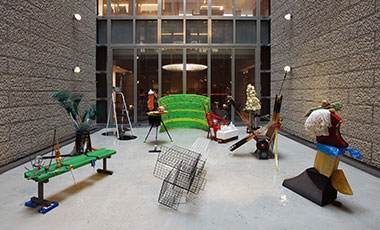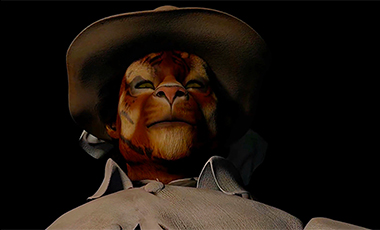The writer observes the past and present of Asia in the international exchange exhibition, and delivers the curators' effort to have a fresh and independent angle to Asia, which has been defined by the western oriented view. This text is based on the class and discussion from the lecture program at Meeting in Asia, which is led by Korea Arts Management Service and Meetingroom. At there, young curators from all over East Asia shared their vision and the experiences in the curating process.
To curate an international joint exhibition in a certain region, one should consider the possibility of a new definition and the position of the region, as well as to introduce the representative local artists, who instinctively embody the regional situation. Magiciens de la Terre (1989, Pompidou Center, Paris) was a large-scale exhibition, which introduced the artworks of non-Western artists to European art scene. At the time, the instruction on Chinese art was simultaneously given to the public so that the exhibition could pose an earnest discussion on the meaning of “Asia” to the art scene. However, a major criticism was that the exhibition only revealed the colonialist view when discoursing and interpreting non-Western art, and therefore barely away from being just a formal act. Still, it is hard to deny that the exhibition generated momentum to develop an independent internal discourse which lead to an increase in research and discussion from an Asian perspective.
 Above) Research Lounge-Index Room at The Subtle Triangle, Seoul Museum of Art, 2015 ⓒ Hong-Chul-ki / Seoul Museum of Art
Above) Research Lounge-Index Room at The Subtle Triangle, Seoul Museum of Art, 2015 ⓒ Hong-Chul-ki / Seoul Museum of Art
Curation of International Exhibition Speaks about “Asia”
After 1990s, the international joint exhibition has become regularized, as well as the argument on Asia has been continued in Under Construction: New Dimensions of Asian Art(2002, Opera Gallery, Japan), which was produced in collaboration of the curators from 7 different Asian countries, and Cities on the Move: Urban Chaos and Global Change, East Asia Art, Architecture and Films Now (1997~2000, Hayward Gallery, London, etc.), which curated by Hou Hanru and Hans-Ulrich Obrist. The curation of these exhibitions was focused on directing the interest of the art scene, which was biased towards the West, rather than Asian countries. The former was to build the network that reflects the local character and research of the Asian curators, while the latter was the genuine introduction of not only the artists and artworks of Asia, but also the art and cultural phenomena like films and architecture and the relevant cities to a Western public. In 2000, Asia Art Archive (AAA) was established in Hong Kong, and those movements have been archived. Currently, the topic of “Asia” keeps on being discussed and became public through the various and specific agendas, as well as led to numerous exhibitions and symposiums.
 Left) Koizumi Meiro, Mnemonic(Father), Video Installation, 6m 20s, 2011, installation view at The Subtle Triangle, Seoul Museum of Art, 2015 ⓒ Hong-Chul-ki / Seoul Museum of Art
Left) Koizumi Meiro, Mnemonic(Father), Video Installation, 6m 20s, 2011, installation view at The Subtle Triangle, Seoul Museum of Art, 2015 ⓒ Hong-Chul-ki / Seoul Museum of ArtRight) Koizumi Meiro, Trapped words, Video Installation, 11m 40s, 2014, installation view at The Subtle Triangle, Seoul Museum of Art, 2015 ⓒ Hong-Chul-ki / Seoul Museum of Art
A Subtle Triangle: the Political Composition of Korea, China and Japan’
To respond to those questions and to share the methodology of curators from different Asian countries, Meeting in Asia - which is a talent training program of international culture exchange led by Meetingroom and Korea Arts Management Service - proceeded the academy program of sharing the examples and information of international joint curations in Asia last April. It was here I introduced the context, composition and the production process of exhibition, The Subtle Triangle (2015, Seoul Museum of Art), to assess the present state and the limitation of exchange history of Korea, China and Japan.
The distinctiveness of the region is worth special mention in Asia. Because the location of 3 countries is close to the last ceasefire area of the world, any political and social crisis brings the need of art and culture, as well as the movement to suggest them as one community. This is followed by the regular exchanges between Asian countries in 1990s and the advent of “the time of Asian biennales,” as well as the diplomatic success of China-Japan-South Korea trilateral summit (1999). The curation of The Subtle Triangle is started with this trend of the time, but intend to avoid the competition between the nations and to face the present as the result of the past, instead of presenting the beautiful and hopeful future. Also, the curation focused on questioning how the series of past history can consist the present and show us the future.
However, the meaning of “the nation” and the “exchange” of the exhibition was interpreted in the sociopolitical context and diplomatic situation, and moreover, the exhibition and the artworks were consumed and explained in favor of politics after the opening. This experience shows that even with the curatorial purpose to find the fresh and critical approach, it is hard to escape from the link to the past and form a new discourse to acquire the contemporary characteristic. In Meeting in Asia, this autobiographical criticism and confession was shared with the other participants’ experiences and drew different critical questions, as well as followed by many conversations till the end of the program.
 Above) 2011 Taipei Biennale Poster, Taipei Biennale is held at Taipei Fine Arts Museum. http://www.taipeibiennial.org
Above) 2011 Taipei Biennale Poster, Taipei Biennale is held at Taipei Fine Arts Museum. http://www.taipeibiennial.org
Crossing Inside and Outside of Asia
Freya Chou, co-curator of the 10th Shanghai Biennale and curator of Para/Site in HongKong, gave a speech on the aspects of Asian biennales - the subject of regionality and the meaning of biennale as the international event under the title of The Possibility and Problem of Asian Art in relation with Biennales of Asian Region. Chou emphasized the importance of communication with the region and the study in advance to settle the biennale system. Also, she mentioned subjects including censorship, political art and region and art, which are frequently discussed in Asian biennales, and intended to search the meaning through the repetitive questions around the problems and limitations. Chou says that Inbetween the local particularity of the biennales of Taiwan and China and the abstract notion of Asia, she wanted to conceptualize something more than “Asian” and “by Asians”. Because the meaning of the subject varies, to find a fixed solution, Chou mentioned that the artist and curator should make effort to liberate the exhibition to form its own meaning and to reinvent this relationship
Ying Kwok was the associate curator of PThe Centre for Chinese Contemporary Art(CFCCA) in Manchester and the curator of PAsia Triennial Manchester(ATM), as well as an independent curator based on Hong Kong. Kwok was invited to give a different perspective on international exchange. Based on her 10 years of curating experience of connecting Asia and Europe in the UK and various program examples, Kwok shared her thoughts on the “identity of Asia”. Kwok researched for 3 years to analyze the audience to settle CFCCA and introduce Chinese art at Manchester, and revealed the result at the speech.
Under the title of Making Links with the City, she introduced the cases of CFCCA and ATM, and reviewed the different perspectives on “Asia” and the meaning of “zone” in contemporary art, as well as focused on the changes of the abstract notion that depend on the character of place. Her interest began with Chinese art from Western point of view, then gradually expended to the attribute of Western world and recently, to the character of Hong Kong, which is placed in the middle. Rather than researching the countries, exploring and experiencing different cities is easier to comprehend the dynamic of the interest, and plan specific roadmap, especially when the “exchange” is the mark. In this respect, the exchange between the cities enables the sharing of common critical thought and concerns, as well as lead to more active discussions.
 Installation view at The Subtle Triangle, Seoul Museum of Art, 2015 ⓒ Hong-Chul-ki / Seoul Museum of Art
Installation view at The Subtle Triangle, Seoul Museum of Art, 2015 ⓒ Hong-Chul-ki / Seoul Museum of Art
New Solidarity Based on “Difference”
Through Meeting in Asia, We could have time to contemplate the problems and issues that lie behind the various forms of exhibitions from different regions. When the postcolonial perspective replaces the established point of view of intolerance, and the understanding of difference is preceded by exposing the coessentiality and distinctiveness, the new interpretation on international joint exhibition is possible. If we avoid a singular translation and observe the subtle disparity to discuss and practice art, new research from another perspective and the autonomous discourse can be rooted. If the public discussion like Meeting in Asia is relocated and recontextualized, and if these movements are archived, an autonomous discourse can be produced. Also, if the multilateral relationship is established, a new solidarity may be possible instead of the simple geopolitical community. The Asian Culture Complex of Gwangju will open at the end of this year, and M+ Museum in Hong Kong will be open in 2019. Both venues are taking note of the topographic change in the art scene that was once western oriented and the new possibility of an autonomous Asian art and cultural discourse. I expect the day, when the diverse strategies and suggestions of Asian curators will be briskly actualized in the public space, is not far away.

Leeji Hong / Curator, Seoul Museum of Art
Hong Lee-ji has graduated from Hongik University in Sculpture, and finished MFA in Curating at Goldsmiths, University of London. She currently is a curator of Seoul Museum of Art, and an editor of the curatorial research platform Meetingroom.


